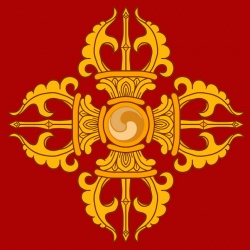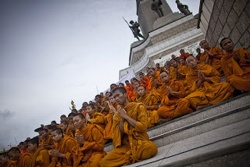Difference between revisions of "Yesh-es-od"
(Created page with " Yeshe-Ö (c. 959 - 1040) (birth name, Khor-re; spiritual names: Jangchub Yeshe-Ö, Byang Chub Ye shes' Od, Lha Bla Ma, Hla Lama Yeshe O, [...") |
|||
| Line 1: | Line 1: | ||
| − | + | <nomobile>{{DisplayImages|3112|3338}}</nomobile> | |
| + | |||
| + | [[Yeshe-Ö]] (c. 959 - 1040) ([[birth]] [[name]], [[Khor-re]]; [[spiritual]] names: [[Jangchub Yeshe-Ö]], [[Byang Chub Ye shes' Od]], [[Lha Bla Ma]], [[Hla Lama Yeshe O]], [[Lalama Yixiwo]], [[bKra shis mgon]]; also [[Dharmaraja]], meaning [[Noble]] [[King]])[1] was the first notable lama-king in [[Tibet]].[2] Yeshe-Ö was a monk-king in [[western Tibet]]. | ||
| + | |||
| + | Born [[Khor-re]], he is better known as [[Lhachen Yeshe-Ö]], his [[spiritual]] [[name]]. He was the second [[king]] in the succession of the {{Wiki|kingdom}} of [[Guge]] in the southwestern [[Tibetan Plateau]]. | ||
| + | |||
| + | The extent of the {{Wiki|kingdom}} was roughly {{Wiki|equivalent}} to the area of the {{Wiki|kingdom}} [[Zhangzhung]] that had existed until the 7th century. [[Yeshe-Ö]] abdicated the [[throne]] c. 975 to become a [[lama]]. | ||
| + | |||
| + | In classical [[Tibetan]] historiography, the restoration of an organized and [[monastic]] [[tradition]] of [[Tibetan Buddhism]] is attributed to [[Yeshe-Ö]]. He built [[Tholing Monastery]] in 997 when [[Tholing]] ({{Wiki|Chinese}}: [[Zanda]]) was the capital of [[Guge]]. [[Yeshe-Ö']] sponsored noviciates, including the great [[translator]] [[Rinchen Zangpo]] | ||
Early [[life]] | Early [[life]] | ||
| − | From a young age, Yeshe-Ö was [[interested]] in [[religious]] matters. As [[King]] Tashi-gon (bKra-shis-mgon) [[died]] without an heir, his nephew, Yeshe-Ö,[1] was invited to take over the rulership which merged the {{Wiki|kingdoms}} of Tashigon and Detsugon into one single {{Wiki|kingdom}} covering the regions of Purang and [[Guge]] and [[Zanskar]], {{Wiki|Spiti}} and {{Wiki|Lahaul}} and Upper {{Wiki|Kinnaur}}.[ | + | From a young age, [[Yeshe-Ö]] was [[interested]] in [[religious]] matters. As [[King]] [[Tashi-gon]] ([[bKra-shis-mgon]]) [[died]] without an heir, his nephew, Yeshe-Ö,[1] was invited to take over the rulership which merged the {{Wiki|kingdoms}} of [[Tashigon]] and [[Detsugon]] into one single {{Wiki|kingdom}} covering the regions of [[Purang]] and [[Guge]] and [[Zanskar]], {{Wiki|Spiti}} and {{Wiki|Lahaul}} and Upper {{Wiki|Kinnaur}}. [[Yeshe-Ö]] assumed the rulership of the combined [[Purnag-Guge]] {{Wiki|Kingdom}} in 967 AD. |
| + | |||
| + | |||
Career | Career | ||
| − | Yeshe-Ö's first act as [[ruler]] was to issue commands decried under the title bka’ shog | + | [[Yeshe-Ö's]] first act as [[ruler]] was to issue commands decried under the title [[bka’ shog chen mo]] ([[Great Dictums]]), which reflected his {{Wiki|theocratic}} approach to {{Wiki|rule}} the {{Wiki|kingdom}} as his primary aim; it was the [[reason]] that he came to be known as "a [[king]] and [[monk]]". In 997, after 30 years on the [[throne]], he established the [[Tholing Monastery]]. |
| + | |||
| + | This orientation was to ensure [[propagation]] of [[Buddhism]] throughout [[Tibet]]. In another command, it was [[essential]] for {{Wiki|farmers}} and nomads to pay an endowment fee towards the maintenance of the [[Tholing Monastery]]. | ||
| + | |||
| + | Another unique act helped in the "[[second diffusion of Buddhism]]" in [[Tibet]], which is solely attributed to [[Yeshe-Ö]]. Based on the practices followed in [[India]], [[Yeshe-Ö]] deputed 21 specially chosen novitiates, aged 10–20, to be trained as [[monks]] in [[Kashmir]] and other parts of [[India]]. | ||
| + | |||
| + | They were to study under [[Indian Buddhist]] [[Gurus]] in renowned {{Wiki|institutions}}, and to translate the [[Buddhist scriptures]] from [[Sanskrit]] to [[Tibetan language]]. Of these 21 novitiates, only two survived: [[Rinchen Zangpo]] and [[Lekpai Sherap]]. The rest of the trainees could not survive the extreme {{Wiki|weather conditions}} of {{Wiki|northern India}}. | ||
| + | |||
| + | [[Rinchen Zangpo]] performance in [[India]] was so impressive that [[Yeshe-Ö]] gave him the {{Wiki|responsibility}} to translate all [[Sanskrit]] [[scriptures]] and also [[to build]] [[monasteries]] in [[Tibet]]. The major [[monasteries]] built under the King's initiative were the [[Tholing Monastery]] the first one in [[western Tibet]], the [[Tabo Monastery]] in {{Wiki|Ladakh}}, and the [[Khochar monastery]]. | ||
| + | |||
| + | He believed in reforming his {{Wiki|kingdom}} under the [[ethos]] of three “R”s namely, [[religious]] [[education]], [[religious]] [[architecture]], and [[religious]] reform, during a time when the [[Indian Buddhist]] [[religious]], artistic, architectural, [[scriptural]] and [[philosophical]] [[traditions]] permeated all the [[Tibetan]] [[world]] through [[Guge]]. | ||
| + | |||
| + | He ruled, along with his brother, in the entire [[Western]] [[Himalayan]] region. He founded [[temples]] and encouraged the [[nobility]] of [[Tibet]]. He opposed the [[esoteric]] [[forms]] of [[tantric practices]] (mostly by non-organised groups) which were prevalent in [[Tibet]]. The large number of artistic works made of bronzes are credited to [[Nagaraja]], one of the two sons of Yeshe-Ö. | ||
| − | |||
| − | |||
Legacy | Legacy | ||
| − | The | + | The [[Tholing Monastery]] in [[Tholing]], built in 997, is the first [[monastery]] credited to [[Yeshe-Ö]]. The 10th century [[Yeshe-Ö]] [[temple]] is under reconstruction after the {{Wiki|Red Guards}} damaged it during the {{Wiki|Cultural Revolution}} in 1967. In the [[Lotsava]] [[Lakhang]] in Riba, in [[Ngari]], field research revealed a painting of eight [[monks]], including [[Rinchen Zangpo]], sent to [[Kashmir]] by [[Yeshe-Ö]] to bring texts of [[scriptures]] of [[Mahayana Buddhism]] from there to [[west]] [[Tibet]]. |
| + | {{R}} | ||
| + | {{Wiki|}} | ||
| + | [[Category:Tibetan Buddhist History]] | ||
Revision as of 16:07, 11 October 2015
Yeshe-Ö (c. 959 - 1040) (birth name, Khor-re; spiritual names: Jangchub Yeshe-Ö, Byang Chub Ye shes' Od, Lha Bla Ma, Hla Lama Yeshe O, Lalama Yixiwo, bKra shis mgon; also Dharmaraja, meaning Noble King)[1] was the first notable lama-king in Tibet.[2] Yeshe-Ö was a monk-king in western Tibet.
Born Khor-re, he is better known as Lhachen Yeshe-Ö, his spiritual name. He was the second king in the succession of the kingdom of Guge in the southwestern Tibetan Plateau.
The extent of the kingdom was roughly equivalent to the area of the kingdom Zhangzhung that had existed until the 7th century. Yeshe-Ö abdicated the throne c. 975 to become a lama.
In classical Tibetan historiography, the restoration of an organized and monastic tradition of Tibetan Buddhism is attributed to Yeshe-Ö. He built Tholing Monastery in 997 when Tholing (Chinese: Zanda) was the capital of Guge. Yeshe-Ö' sponsored noviciates, including the great translator Rinchen Zangpo
Early life
From a young age, Yeshe-Ö was interested in religious matters. As King Tashi-gon (bKra-shis-mgon) died without an heir, his nephew, Yeshe-Ö,[1] was invited to take over the rulership which merged the kingdoms of Tashigon and Detsugon into one single kingdom covering the regions of Purang and Guge and Zanskar, Spiti and Lahaul and Upper Kinnaur. Yeshe-Ö assumed the rulership of the combined Purnag-Guge Kingdom in 967 AD.
Career
Yeshe-Ö's first act as ruler was to issue commands decried under the title bka’ shog chen mo (Great Dictums), which reflected his theocratic approach to rule the kingdom as his primary aim; it was the reason that he came to be known as "a king and monk". In 997, after 30 years on the throne, he established the Tholing Monastery.
This orientation was to ensure propagation of Buddhism throughout Tibet. In another command, it was essential for farmers and nomads to pay an endowment fee towards the maintenance of the Tholing Monastery.
Another unique act helped in the "second diffusion of Buddhism" in Tibet, which is solely attributed to Yeshe-Ö. Based on the practices followed in India, Yeshe-Ö deputed 21 specially chosen novitiates, aged 10–20, to be trained as monks in Kashmir and other parts of India.
They were to study under Indian Buddhist Gurus in renowned institutions, and to translate the Buddhist scriptures from Sanskrit to Tibetan language. Of these 21 novitiates, only two survived: Rinchen Zangpo and Lekpai Sherap. The rest of the trainees could not survive the extreme weather conditions of northern India.
Rinchen Zangpo performance in India was so impressive that Yeshe-Ö gave him the responsibility to translate all Sanskrit scriptures and also to build monasteries in Tibet. The major monasteries built under the King's initiative were the Tholing Monastery the first one in western Tibet, the Tabo Monastery in Ladakh, and the Khochar monastery.
He believed in reforming his kingdom under the ethos of three “R”s namely, religious education, religious architecture, and religious reform, during a time when the Indian Buddhist religious, artistic, architectural, scriptural and philosophical traditions permeated all the Tibetan world through Guge.
He ruled, along with his brother, in the entire Western Himalayan region. He founded temples and encouraged the nobility of Tibet. He opposed the esoteric forms of tantric practices (mostly by non-organised groups) which were prevalent in Tibet. The large number of artistic works made of bronzes are credited to Nagaraja, one of the two sons of Yeshe-Ö.
Legacy
The Tholing Monastery in Tholing, built in 997, is the first monastery credited to Yeshe-Ö. The 10th century Yeshe-Ö temple is under reconstruction after the Red Guards damaged it during the Cultural Revolution in 1967. In the Lotsava Lakhang in Riba, in Ngari, field research revealed a painting of eight monks, including Rinchen Zangpo, sent to Kashmir by Yeshe-Ö to bring texts of scriptures of Mahayana Buddhism from there to west Tibet.
Source
[[Wikipedia:|]]

